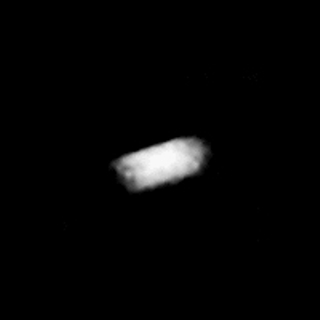Galatea (moon)
Galatea or Neptune VI, is the fourth closest moon to Neptune. It is named after Galatea, one of the Nereids of Greek legend.

| |
| Discovery | |
|---|---|
| Discovered by | Stephen P. Synnott |
| Discovered in | July 1989 |
| Orbital characteristics | |
| Epoch 18 August 1989 | |
| Semi-major axis | 61 953 ± 1 km |
| Orbital eccentricity | 0.00004 ± 0.00009 |
| Orbital period | 0.42874431 ± 0.00000001 d |
| Inclination | 0.052 ± 0.011° (to Neptune equator) 0.06° (to local Laplace plane) |
| Is a moon of | Neptune |
| Physical characteristics | |
| Dimensions | 204×184×144 km (±~10 km) |
| Mass | 2.12 ± 0.08 ×1018 kg |
| Mean density | 0.75 ± 0.1 g/cm3 |
| Rotation period | assumed synchronous |
| Axial tilt | ~zero presumably |
| Albedo (geometric) | 0.08 |
| Surface temp. | ~51 K mean (estimate) |
| Atmosphere | none |
- There is also an asteroid called 74 Galatea.
Galatea was found in late July 1989 from the images taken by the Voyager 2 probe. It was given the designation S/1989 N 4. The discovery was said (IAUC 4824) on August 2, 1989, but the text only talks of "10 frames taken over 5 days", giving a discovery date of sometime before July 28. The name was given on 16 September 1991.
It is not a sphere and shows no sign of any geological changes.
Galatea (moon) Media
Other websites
![]() Media related to Galatea (moon) at Wikimedia Commons
Media related to Galatea (moon) at Wikimedia Commons
- Galatea Profile Archived 2007-08-01 at the Wayback Machine by NASA's Solar System Exploration
